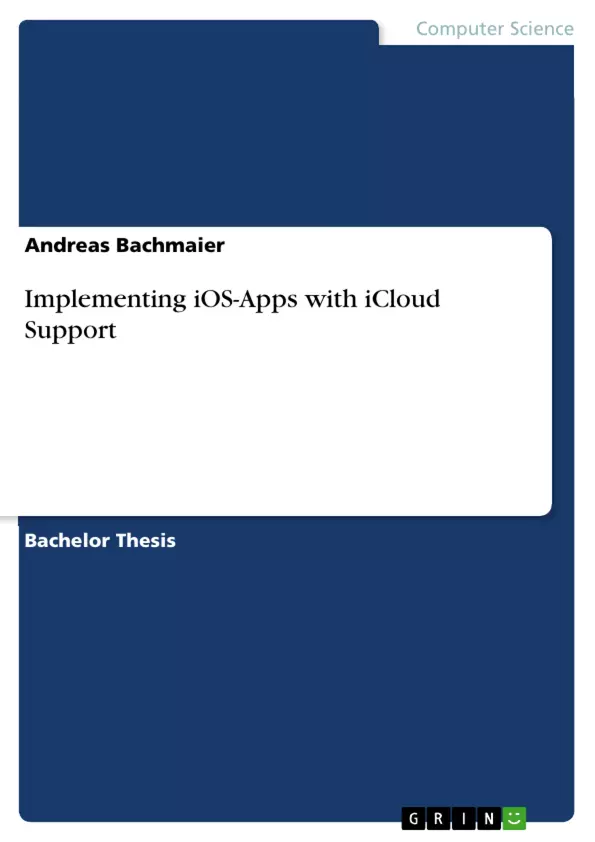
Implementing iOS-Apps with iCloud Support
Bachelorarbeit, 2013
39 Seiten, Note: 1
Leseprobe
Table of Contents
- 1 Introduction
- 1.1 What is Cloud Computing?
- 1.2 iCloud Overview
- 2 iCloud
- 2.1 Users view of iCloud
- 2.2 Developers view of iCloud
- 2.2.1 Testing & Debugging
- 3 Comparison iCloud with other Cloud Services
- 4 Saving data on the device
- 4.1 Property Lists
- 4.1.1 NSUserDefaults
- 4.1.2 Settings Bundle
- 4.1.3 Archiving Objects
- 4.2 Documents
- 4.2.1 File System
- 4.2.2 UIDocument
- 4.3 Database
- 4.3.1 SQLite
- 4.3.2 Core Data
- 5 Saving data in the iCloud
- 5.1 Key-Value Storage
- 5.2 Document Storage
- 5.2.1 Update Notification
- 5.2.2 Conflict Handling
- 5.3 Core Data Storage
- 5.3.1 Update Notification
- 5.3.2 Conflict Handling
- 6 Summary
Objectives and Key Themes
The objective of this bachelor's thesis is to demonstrate how to develop iOS applications that utilize iCloud for data storage and synchronization. The paper aims to provide a practical guide for developers, covering various aspects of data storage and management within the Apple ecosystem.
- iCloud integration in iOS app development
- Data storage methods on iOS devices (key-value, documents, databases)
- Comparison of iCloud with other cloud services
- Data synchronization techniques using iCloud
- Practical application example of location-based data storage
Chapter Summaries
1 Introduction: This introductory chapter sets the stage by highlighting the increasing importance of data synchronization across multiple devices in both professional and personal contexts. It provides an overview of cloud computing, defining the concept and explaining different service models (SaaS, PaaS, IaaS). The chapter then specifically introduces iCloud as Apple's cloud solution and outlines the paper's scope, focusing on developing iOS applications that leverage iCloud for data storage. The chapter concludes by briefly outlining the structure of the paper and the development of a simple location-based application as a practical demonstration.
2 iCloud: This chapter delves into iCloud from both the user and developer perspectives. From the user's standpoint, it explores the functionalities and features accessible to end-users. From the developer's perspective, it lays the groundwork for building iCloud-integrated applications, likely including details on APIs, SDKs, and best practices. A specific subsection on testing and debugging further aids developers in building robust and reliable applications.
4 Saving data on the device: This chapter explains several methods for saving data locally on iOS devices, which serves as a foundation for understanding iCloud integration. It covers various approaches, ranging from simple key-value pairs using NSUserDefaults and Settings Bundles, to more complex mechanisms such as archiving objects, managing documents through the file system and UIDocument, and utilizing databases with SQLite and Core Data. This provides a comprehensive view of local data management techniques necessary for seamless data synchronization with iCloud.
5 Saving data in the iCloud: This chapter builds upon the previous chapter by detailing how to save data to iCloud. It explores different iCloud storage mechanisms, including key-value storage, document storage, and Core Data storage. For each type of storage, specific details on update notifications and conflict handling are provided, showcasing techniques to manage data consistency across devices. This crucial section likely includes detailed code examples and best practices for implementing each method effectively.
Keywords
iPhone, iPad, iCloud, data synchronization, iOS app development, cloud computing, data storage, key-value storage, document storage, Core Data, SQLite, NSUserDefaults, UIDocument, conflict handling, update notification.
Frequently Asked Questions: iOS App Development with iCloud
What is the main focus of this document?
This document is a comprehensive preview of a bachelor's thesis focusing on developing iOS applications that utilize iCloud for data storage and synchronization. It provides a practical guide for developers, covering various aspects of data storage and management within the Apple ecosystem.
What topics are covered in the document?
The document covers a wide range of topics, including: an introduction to cloud computing and iCloud; iCloud from both user and developer perspectives; different methods for saving data locally on iOS devices (key-value pairs, archiving objects, file system, UIDocument, SQLite, Core Data); saving data to iCloud using key-value storage, document storage, and Core Data storage; handling update notifications and conflict resolution in iCloud; and a comparison of iCloud with other cloud services. The document also includes a table of contents, objectives and key themes, chapter summaries, and keywords.
What are the key themes explored in the document?
Key themes include iCloud integration in iOS app development, data storage methods on iOS devices, comparing iCloud to other cloud services, data synchronization techniques using iCloud, and practical application examples (a location-based data storage application is mentioned).
How is data stored locally on iOS devices according to the document?
The document details several local data storage methods: key-value pairs using NSUserDefaults and Settings Bundles, archiving objects, managing documents via the file system and UIDocument, and using databases (SQLite and Core Data).
What are the different methods for saving data to iCloud?
The document describes three main iCloud storage mechanisms: key-value storage, document storage, and Core Data storage. Each method's handling of update notifications and conflict resolution is discussed.
How does the document address conflict handling and update notifications in iCloud?
The document specifically addresses conflict handling and update notification mechanisms for each type of iCloud data storage (key-value, document, and Core Data), providing techniques to maintain data consistency across devices.
What is the purpose of the chapter summaries?
The chapter summaries provide a concise overview of the content of each chapter, outlining the key concepts and information covered in each section of the thesis.
What is included in the introduction chapter?
The introduction chapter sets the context by discussing the importance of data synchronization, provides an overview of cloud computing and iCloud, defines the scope of the thesis, and outlines the structure of the document, including a mention of a practical location-based application example.
What is covered in the iCloud chapter?
The iCloud chapter examines iCloud from both user and developer perspectives, covering user functionalities and developer-centric aspects like APIs, SDKs, best practices, and testing and debugging.
What are the keywords associated with this document?
Keywords include iPhone, iPad, iCloud, data synchronization, iOS app development, cloud computing, data storage, key-value storage, document storage, Core Data, SQLite, NSUserDefaults, UIDocument, conflict handling, and update notification.
Details
- Titel
- Implementing iOS-Apps with iCloud Support
- Hochschule
- Fachhochschule Technikum Wien (Informations- und Kommunikationssysteme)
- Veranstaltung
- Smartphone Platforms
- Note
- 1
- Autor
- Andreas Bachmaier (Autor:in)
- Erscheinungsjahr
- 2013
- Seiten
- 39
- Katalognummer
- V210118
- ISBN (eBook)
- 9783656381785
- ISBN (Buch)
- 9783656382713
- Dateigröße
- 928 KB
- Sprache
- Englisch
- Schlagworte
- iCloud iPhone iPad iOS
- Produktsicherheit
- GRIN Publishing GmbH
- Preis (Ebook)
- US$ 17,99
- Preis (Book)
- US$ 19,99
- Arbeit zitieren
- Andreas Bachmaier (Autor:in), 2013, Implementing iOS-Apps with iCloud Support, München, Page::Imprint:: GRINVerlagOHG, https://www.diplomarbeiten24.de/document/210118
- Autor werden
- Ihre Optionen
- Vertriebskanäle
- Premium Services
- Autorenprofil
- Textarten und Formate
- Services für Verlage, Hochschulen, Unternehmen

- © GRIN Publishing GmbH.
- Alle Inhalte urheberrechtlich geschützt. Kopieren und verbreiten untersagt.
- info@grin.com
- AGB
- Open Publishing
Der GRIN Verlag hat sich seit 1998 auf die Veröffentlichung akademischer eBooks und Bücher spezialisiert. Der GRIN Verlag steht damit als erstes Unternehmen für User Generated Quality Content. Die Verlagsseiten GRIN.com, Hausarbeiten.de und Diplomarbeiten24 bieten für Hochschullehrer, Absolventen und Studenten die ideale Plattform, wissenschaftliche Texte wie Hausarbeiten, Referate, Bachelorarbeiten, Masterarbeiten, Diplomarbeiten, Dissertationen und wissenschaftliche Aufsätze einem breiten Publikum zu präsentieren.
Kostenfreie Veröffentlichung: Hausarbeit, Bachelorarbeit, Diplomarbeit, Dissertation, Masterarbeit, Interpretation oder Referat jetzt veröffentlichen!
- GRIN Verlag GmbH
-
- Nymphenburger Str. 86
- 80636
- Munich, Deutschland
- +49 89-550559-0
- +49 89-550559-10
- info@grin.com
-









